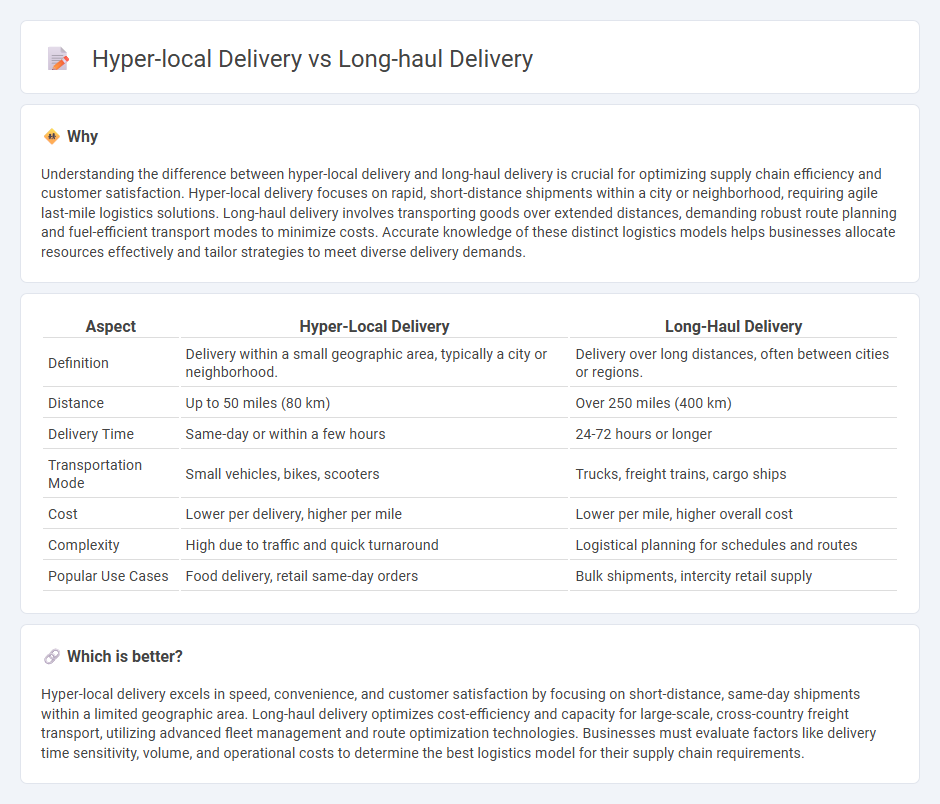
Hyper-local delivery focuses on rapid, short-distance shipments within a specific urban area, optimizing route efficiency and customer satisfaction through real-time tracking and local inventory management. Long-haul delivery involves transporting goods over extensive distances, relying on large-scale logistics networks, freight optimization, and regulatory compliance to ensure timely and cost-effective shipments. Explore the key benefits and challenges of each delivery method to enhance your supply chain strategy.
Why it is important
Understanding the difference between hyper-local delivery and long-haul delivery is crucial for optimizing supply chain efficiency and customer satisfaction. Hyper-local delivery focuses on rapid, short-distance shipments within a city or neighborhood, requiring agile last-mile logistics solutions. Long-haul delivery involves transporting goods over extended distances, demanding robust route planning and fuel-efficient transport modes to minimize costs. Accurate knowledge of these distinct logistics models helps businesses allocate resources effectively and tailor strategies to meet diverse delivery demands.
Comparison Table
| Aspect | Hyper-Local Delivery | Long-Haul Delivery |
|---|---|---|
| Definition | Delivery within a small geographic area, typically a city or neighborhood. | Delivery over long distances, often between cities or regions. |
| Distance | Up to 50 miles (80 km) | Over 250 miles (400 km) |
| Delivery Time | Same-day or within a few hours | 24-72 hours or longer |
| Transportation Mode | Small vehicles, bikes, scooters | Trucks, freight trains, cargo ships |
| Cost | Lower per delivery, higher per mile | Lower per mile, higher overall cost |
| Complexity | High due to traffic and quick turnaround | Logistical planning for schedules and routes |
| Popular Use Cases | Food delivery, retail same-day orders | Bulk shipments, intercity retail supply |
Which is better?
Hyper-local delivery excels in speed, convenience, and customer satisfaction by focusing on short-distance, same-day shipments within a limited geographic area. Long-haul delivery optimizes cost-efficiency and capacity for large-scale, cross-country freight transport, utilizing advanced fleet management and route optimization technologies. Businesses must evaluate factors like delivery time sensitivity, volume, and operational costs to determine the best logistics model for their supply chain requirements.
Connection
Hyper-local delivery and long-haul delivery are interconnected by the seamless integration of last-mile fulfillment with extended transportation networks. Efficient logistics systems leverage advanced routing algorithms and real-time tracking to optimize the transfer of goods from regional distribution centers to hyper-local hubs. This coordination reduces delivery times, lowers operational costs, and enhances customer satisfaction across diverse geographic scales.
Key Terms
**Long-haul delivery:**
Long-haul delivery involves transporting goods over extensive distances, often across states or countries, utilizing large freight trucks, airplanes, or trains to optimize efficiency and reduce transit time. This method supports supply chain operations by ensuring bulk shipments reach regional distribution centers or major retail hubs promptly, emphasizing reliability and scalability. Explore more insights on long-haul delivery strategies and their impact on global logistics networks.
Linehaul
Linehaul delivery focuses on transporting goods over long distances between regional distribution centers, optimizing fuel efficiency and route planning to reduce transit times and costs. This method contrasts sharply with hyper-local delivery, which concentrates on last-mile logistics within a small geographic area, emphasizing speed and frequent stops. Explore the strategic advantages of linehaul to enhance your supply chain efficiency.
Freight consolidation
Freight consolidation plays a critical role in both long-haul and hyper-local delivery by optimizing shipment volumes to reduce costs and improve efficiency. In long-haul delivery, consolidation aggregates goods from multiple shippers to maximize load capacity across extended distances, minimizing transportation expenses and environmental impact. Explore the strategic benefits of freight consolidation in enhancing supply chain performance and reducing logistical complexities.
Source and External Links
Long-Haul Delivery -- Application Areas - Veeroute - Long-haul delivery involves transporting cargo such as raw materials and goods over long distances both domestically and internationally, accounting for 60 to 75% of global freight traffic, with efficiency improved by automating logistics management and optimizing route planning.
Long Haul Trucking Services - Schneider - Long-haul trucking is ideal for shipments over 250 miles, including dry van, specialty chemicals, liquid bulk, cross-border, and intermodal freight, with tools like FreightPower offering real-time freight management for reliable, secure delivery.
Short Haul vs Long Haul in Trucking - Melton Trucking - Long-haul trucking refers to loads exceeding 250 miles, often crossing state or country lines, with distinct differences in distance, equipment, routes, and driver lifestyle compared to short-haul trucking.
 dowidth.com
dowidth.com